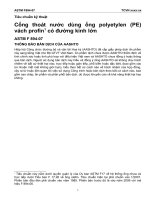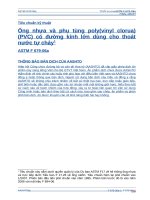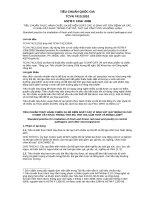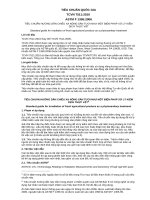Astm f 1251 89 (2003)
Bạn đang xem bản rút gọn của tài liệu. Xem và tải ngay bản đầy đủ của tài liệu tại đây (52.68 KB, 6 trang )
Designation: F 1251 – 89 (Reapproved 2003)
Standard Terminology Relating to
Polymeric Biomaterials in Medical and Surgical Devices1
This standard is issued under the fixed designation F 1251; the number immediately following the designation indicates the year of
original adoption or, in the case of revision, the year of last revision. A number in parentheses indicates the year of last reapproval. A
superscript epsilon (e) indicates an editorial change since the last revision or reapproval.
2. Referenced Documents
2.1 ASTM Standards:
D 638 Test Method for Tensile Properties of Plastics2
D 747 Test Method for Apparent Bending Modulus of
Plastics by Means of a Cantilever Beam2
D 790 Test Methods for Flexural Properties of Unreinforced
and Reinforced Plastics and Electrical Insulating Materials2
D 882 Test Methods for Tensile Properties of Thin Plastic
Sheeting2
D 1003 Test Method for Haze and Luminous Transmittance
of Transparent Plastics2
SI 10 –02 American National Standard for Use of the
International System of Units (SI): The Modern Metric
System3
1. Scope
1.1 This terminology covers polymeric biomaterials in
medical and surgical devices. Terms are defined as they are
used relative to medical and surgical materials and devices.
Terms that are generally understood and in common usage or
adequately defined in other readily available references are not
included except where particular delineation to biomaterials
may be more clearly stated.
1.2 This terminology is therefore intended to be selective of
terms used generally in materials science and technology and
published in a number of documents, such as those listed in the
succeeding sections. The listing is also intended to define terms
that appear prominently within other ASTM standards and do
not appear elsewhere.
1.3 The definitions are substantially identical to those published in other ASTM standards on metals, ceramics and glass,
rubbers and polymers, and so forth, or published by other
standards writing organizations, such as International Standards Organization (ISO), American Institute of Mechanical
Engineers (AIME), American Society of Plastic and Reconstructive Surgeons (ASPR), and Tissue Culture Association
(TCA).
1.4 A need exists for this terminology to supplement current
documents on terminology which concentrate on materials.
This terminology covers each of the following disciplines:
plastics (polymers), rubber (elastomers), and textiles (polymer
derived).
1.5 An increasing number of product (polymeric, metallurgical, and ceramic types) designations and designations for
chemical, physical, mechanical, and analytical tests and standards are coming into common usage in the literature and
commerce of biomaterials in medical and surgical devices and
clinical services. Section 2 lists those documents referenced in
this terminology.
1.6 Table 1 lists abbreviated, anagramic designations. Annex A1 is a thesaurus of general usage terms relating to
biomaterials.
3. Terminology
3.1 Definitions:
acetal plastic, n—a plastic based on polymers having a
predominance of acetal linkages in the main chain. (See also
polyoxymethylene.)
D20
acrylic plastic, n—a plastic based on polymers made with
acrylic acid or a structural derivative of acrylic acid. D20
addition polymerization, n—polymerization in which monomers are linked together without the splitting off of water or
other simple molecules and involves the opening of a double
bond.
D20
aging, n—the process of exposing materials to an environment
for an interval of time.
D20
aging effect, n—a change in a material brought about by
exposure of the material to an environment for an interval of
time.
alkyd resin, n—a polyester convertible into a crosslinked
form; requiring a reactant of functionality higher than two,
or having double bonds.
D20
apparent density—see density, apparent.
artificial weathering, n—exposure of a material to laboratory
conditions that simulate outdoor weathering.
DISCUSSION—Exposure conditions may be cyclic, involving changes
1
This terminology is under the jurisdiction of ASTM Committee F04 on Medical
and Surgical Materials and Devicesand is the direct responsibility of Subcommittee
F04.11on Polymeric Materials.
Current edition approved Apr. 10, 2003. Published May 2003. Originally
approved in 1989. Last previous edition approved in 1995 as F 1251 – 89 (1995).
2
3
Annual Book of ASTM Standards, Vol 08.01.
Excerpts in Related Material sections of all other volumes.
Copyright © ASTM International, 100 Barr Harbor Drive, PO Box C700, West Conshohocken, PA 19428-2959, United States.
1
F 1251 – 89 (2003)
TABLE 1 Abbreviated, Anagramic Designations—AcronymsA,B
Term
AAS
ABC
ABS
AN
ATR-IR
CA
CAB
CP
DSC
DTA
EDTA
EPM/EPDM
EPR
ESCA
ETFE
FEP
GC
HEMA
HPLC
IR
kPA
MPa
MW (mw)
MWD (mwd)
MRI
MRS
NBR
NMR (nmr)
PB
PC
PCTFE
PDMS
PE
PET
PFA
PMMA
PTFE
PU
PVA
PVAc
PVC
PVDC
PVP
RTV
SAN
SB
SEM
SR
TEM
TAR
TER
THR
TJR
TKR
TSR
TWR
UHMW
UMHWPE
UV
VCM
XPS
XRD
A
B
Classification
Descriptive Term in Full
analytic, chemical
plastic, polymer
plastic, polymer
polymer, monomer
analytic, chemical
plastic, polymer
plastic, polymer
plastic, polymer
analytic, physical
analytic, physical
analyses
elastomer
elastomer
analytic, chemical
analytic, chemical
plastics, polymers
analytic, chemical
plastic, polymer
analytic, chemical
analytic, physical
mechanical, physical
mechanical, physical
physical, molecular
physical, molecular
clinical
analytic, chemical
elastomer, polymer
analytic, physical
elastomer, polymer
plastic, polymer
plastic, polymer
elastomer, polymer fluid
plastic, polymer
plastic, polymer
plastic, polymer
plastic, polymer
plastic, polymer
plastic or elastomer polymer
plastic, polymer
plastic, polymer
plastic, polymer
plastic, polymer
polymer
elastomer, plastic
elastomer, polymer
elastomer, polymer
analytic, microscopy
elastomer, polymer
analytic, microscopy
device or prosthesis
device or prosthesis
device or prosthesis
device or prosthesis
device or prosthesis
device or prosthesis
device or prosthesis
plastic, polymer
plastic, polymer
analytic, physical
polymer, monomer
analytic, chemical
analytic, physical
atomic absorption spectroscopy
acryline bone cement
acrylonitrile-butadiene-styrene polymer
acrylonitrile
attenuated total reflectance—infrared
cellulose acetate (sheet X ray)
cellulose acetate-butyrate
cellulose propionate or cellulose acetate-propionate
differential scanning calorimetry
differential thermal analysis
ethylene dinitrilo tetraacetic acid
ethylene-propylene terpolymer
see EPM/EDPM above
used for X-ray photoelectron spectroscopy
(ethylene-tetrafluoroethylene-fluoroplastics)
perfluoro(ethylene-propylene) copolymer
gas chromatography
hydroxyethyl methacrylate (polymer)
high performance liquid chromatography
infrared spectroscopy (for example, IR scan)
kiloPascal (unit of pressure—see Practice E 380, Appendix)
megaPascal (unit of pressure—see Practice E 380, Appendix)
molecular weight
molecular weight distribution (see mw, above)
magnetic resonance imaging (diagnostic application of nmr)
magnetic resonance spectroscopy (diagnostic application of nmr)
nitrile-butadiene rubber
nuclear magnetic resonance
polybutylene
polycarbonate
polychlorotrifluoroethylene
silicone, polydimethyl siloxane
polyethylene
poly(ethylene terephthalate)
perfluoroalkoxy fluorocarbon polymer
poly(methyl methacrylate)
polytetrafluoroethylene
polyurethane
poly(vinyl alcohol) (often poly(vinyl acetate))
poly(vinyl acetate)
poly(vinyl chloride)
poly(vinylidene chloride)
poly(vinyl pyttolidone)
room temperature vulcanization
styrene-acrylonitrile polymer
styrene-butadiene polymer
scanning electron microscopy (cf TEM)
styrene rubber (elastomer)
transmission electron microscopy (cf SEM)
total ankle replacement
total elbow replacement
total hip replacement
total joint replacement
total knee replacement
total shoulder replacement
total wrist replacement
ultrahigh molecular weight polyethylene (stated polymer)
ultrahigh molecular weight polyethylene (see UHMW)
ultraviolet light spectroscopy
vinyl chloride monomer content
X-ray photoelectric spectroscopy (also called ESCA)
X-ray diffraction
If a method or name is used for the first time in a text (paper, etc.), it must be presented in full with the abbreviation in brackets.
If the text is long or consists of several chapters, the full name must be repeated in reasonable sequences, at least when first mentioned in a new chapter.
sharply defined, somewhat resembling in shape a blister on
the human skin.
D20
block copolymer, n—an essentially linear copolymer in which
there are repeated sequences of polymeric segments of
different chemical structure.
D20
bloom, n—a visible exudation or efflorescence of a performance additive on the surface of a material.
D20
in temperature, relative humidity, radiant energy, and many other
elements found in the atmosphere in various geographical areas. The
laboratory exposure conditions are usually intensified beyond those
encountered in actual out-door exposure to accelerate the effect.
D20
blister, n—in sheet plastics, an imperfection, a rounded elevation of the surface, with boundaries that may be more or less
2
F 1251 – 89 (2003)
bulk density—the weight per unit volume of a material
including voids inherent in the material as tested.
DISCUSSION—Cure may be accomplished, for example, by removal of
solvent or crosslinking.
ISO
DISCUSSION—This term is sometimes used synonymously with apparent density.
degradation, n—a deleterious change in the chemical structure, physical properties, or appearance of a plastic.
density, apparent, n—the weight in air of a unit of volume of
a material.
bulk factor, n—the ratio of the volume of a given mass of
molding material to its volume in the molded form.
DISCUSSION—This term is sometimes used synonymously with bulk
density.
DISCUSSION—The bulk factor is also equal to the ratio of the density
of the material to its apparent density in the unmolded form. D20
ISO
density, bulk, n—the weight in air of a unit of volume of a
material.
butylene plastic—plastic based on resins made by the polymerization of butene or copolymerization of butene with one
or more unsaturated compounds, the butene being in greatest
amount by weight.
D20
cast film, n—a film made by depositing a layer of plastic,
either molten, in solution, or in a dispersion, onto a surface,
solidifying the deposit and removing the film from the
surface.
D20
cell, n—a small partially or completely enclosed cavity. D20
cell, closed—see closed cell.
cell, open—see open cell.
chemically foamed polymeric material, n—a cellular material in which the cells are formed by gases generated by
thermal decomposition or other chemical reaction.
D20
chlorofluorocarbon plastic, n—a plastic based on polymers
made with monomers composed of chlorine, fluorine, and
carbon only.
ISO
chlorofluorohydrocarbon plastic, n—a plastic based on polymers made with monomers composed of chlorine, fluorine,
hydrogen, and carbon only.
ISO
closed cell, n—a cell totally enclosed by its walls and hence
not interconnecting with other cells. (See also cell and open
cell.)
ISO
closed-cell foamed plastic, n—a plastic in which almost all
the cells are noninterconnecting.
D20
cold flow—see preferred term creep.
compression molding, n—a process for molding a material in
a confined cavity by applying pressure and usually heat.
D20
condensation polymer, n—polymerization in which during an
acid/base reaction a small molecule is often split out.
copolymer, n—a polymer consisting of molecules characterized by the repetition (neglecting ends, branch junctions and
other irregularities) of two or more different types of
monomeric units. See polymer.
D20
copolymerization—see polymerization and copolymer.
crazing, n—apparent fine cracks at or under the surface of a
plastic.
DISCUSSION—This term is commonly used synonymously with apparent density (1973).
D20
elastomer, n—a macromolecular material that at room temperature returns rapidly to approximately its initial dimensions and shape after substantial deformation by a weak
stress and release of the stress.
D20
epoxy plastic, n—a thermoplastic or thermosetting plastic
containing ether or hydroxyalkyl repeating units, or both,
resulting from the ring-opening reactions of lower-molecular
weight polyfunctional oxirane resins, or compounds, with
catalysts or with various polyfunctional acidic or basic
coreactants.
DISCUSSION—Epoxy plastics often are modified by the incorporation
of diluents, plasticizers, fillers, thixotropic agents, or other materials.
D20
ethylene plastic—a plastic based on polymers of ethylene or
copolymers of ethylene with other monomers, the ethylene
being in greatest amount by mass.
ISO
filler, n—a relatively inert material added to a plastic to modify
its strength, performance, working properties, or other qualities, or to lower costs. (See also reinforced plastic.)
film, n—in plastics, term for sheeting having a nominal
thickness not greater than 0.25 mm (0.01 in.). (See also
sheeting.)
fluorocarbon plastic, n—a plastic based on polymers made
with monomers composed of fluorine and carbon only.
DISCUSSION—When the monomer is essentially tetrafluoro-ethylene,
the prefix TFE may be used to designate these materials. When the
resins are copolymers of tetrafluoro-ethylene and hexafluoropropylene,
the resins may be designated with the prefix FEP. Other prefixes may be
adopted to designate other fluorocarbon plastics.
ISO
fluorohydrocarbon plastic, n—a plastic based on polymers
made with monomers composed of fluorine, hydrogen, and
carbon only.
ISO
fluoroplastic, n—a plastic based on polymers with monomers
containing one or more atoms of fluorine or copolymers of
such monomers with other monomers, the fluorinecontaining monomer(s) being in greatest amount by mass.
(See also fluorocarbon plastic, chlorofluorocarbon plastic, fluorohydrocarbon plastic, and chlorofluorohydrocarbon plastic.)
gel, n—in polymer, a semisolid system consisting of a network
of solid aggregates in which liquid is held.
DISCUSSION—The crazed areas are composed of polymeric material
of lower density than the surrounding matrix.
creep, n—the time-dependent part of strain resulting from
stress.
cure, v—to change the properties of a polymeric system into a
more stable, usable condition by the use of heat, radiation, or
reaction with chemical additives.
3
F 1251 – 89 (2003)
pit, n—in plastics, an imperfection, a small crater in the
surface, the depth and width of which are approximately the
same order of magnitude.
plastic, n—any of numerous polymeric materials that are
usually thermoplastic or thermosetting, of high molecular
weight and that can be molded, cast extruded, drawn,
laminated, or otherwise fabricated into objects, powders,
beads, films, filaments, fibers, or other shapes (Webster
Modified).
plasticizer, n—a substance incorporated into a material to
increase its workability, flexibility, or distensibility of the
material.
plastisol, n—a liquid suspension of a finely divided PVC
polymer or copolymer in a plasticizer.
DISCUSSION—Gels have very low strengths and do not flow like a
liquid. They are soft, flexible, and may rupture under their own weight
unless supported externally.
gel, n—in polymerization, the initial jelly-like solid phase that
develops during the formation of a resin from a liquid.
gel, n—with vinyl plastisols, a state between liquid and solid
that occurs in the initial stages of heating, or upon prolonged
storage.
haze, n—in plastics, the cloudy or turbid aspect or appearance
of an otherwise transparent material caused by light scattered
from within the specimen or from its surfaces.
DISCUSSION—For the purpose of Test Method D 1003, haze is the
percentage of transmitted light which, in passing through the specimen,
deviates from the incident beam through forward scatter more than 2.5°
on the average.
DISCUSSION—The polymer does not dissolve appreciably in the
plasticizer at room temperature but does dissolve at elevated temperatures to form a homogeneous plastic mass (plasticized polymer).
isotactic, adj—pertaining to a type of polymeric molecular
structure containing a sequence of regularly spaced asymmetric atoms arranged in like configuration in a polymer
chain.
laminate, n—a product made by bonding together two or more
layers of material or materials.
polybutylene, n—a polymer prepared by the polymerization of
butene as the sole monomer. (See also polybutylene plastic
and butylene plastic.)
polybutylene plastic, plastic based on polymers made with
butene as essentially the sole monomer.
D20
polycarbonate, n—a polymer in which the repeating structural
unit in the chain is a carbonic acid ester of Bisphenol A.
D20
polyester, n—a polymer in which the repeated structural unit
in the chain is of the ester type.
DISCUSSION—A single resin-impregnated sheet of paper, fabric, or
glass mat, for example, is not considered a laminate. Such a singleISO
sheet construction may be called a “lamina.”
laminate, cross-plied, n—a nonparallel laminate.
laminate, parallel, n—a laminate in which all layers or plies
are oriented with their principal direction (grain or strongest
direction in tension) parallel with the principal direction of
the laminate.
melamine plastic, n—plastic based on resins made by the
condensation or melamine and aldehydes.
D20
monomer, n—a relatively simple compound which can react to
form a polymer. (See also polymer.)
D14, D20
nylon plastic, n—a plastic based on resins composed principally of a long-chain synthetic polymeric amide which has
recurring amide groups as an integral part of the main
polymer chain.
D20
olefin plastic, n—a plastic based on polymers made by the
polymerization of olefins or copolymerization of olefins with
other monomers, the olefins being at least 50 mass %.
D11, D20, F17
oligomer, n—a polymer consisting of only a few monomer
units such as a dimer, trimer, tetramer, and so forth, or their
mixtures.
open cell, n—a cell not totally enclosed by its walls, and hence
interconnecting with other cells. (See closed cell.)
organosol, n—a suspension of a finely divided plastic in a
plasticizer, together with a volatile organic liquid.
DISCUSSION—The polyester is linear and thermoplastic if derived,
either actually or formally, from (a) mono-hydroxy-mono-carboxylic
acids by selfesterification, or (b) the interaction of diols and dicarboxylic acids.
ISO
polyether, n—a polymer in which the repeated structural unit
in the chain is of the ether type.
D20
polyethylene, n—a polymer prepared by the polymerization of
ethylene as the sole monomer. (See also polyethylene
plastic and ethylene plastic.)
polyethylene plastic—a plastic based on polymers made with
ethylene as essentially the sole monomer.
DISCUSSION—In common usage for this plastic, essentially means no
less than 85 % ethylene and no less than 95 % total olefins.
polyethylene terephthalate, n—a polymer derived from
terephthalic acid and ethylene glycol by condensation polymerization.
polymer, n—a substance consisting of molecules characterized
by the repetition (neglecting ends, branch junctions, and
other minor irregularities) of one or more types of monomeric units. (See copolymer.)
IUPAC
polymerization—a chemical reaction in which monomers are
linked together to form polymers. (See also polycondensation and polyaddition.)
D20
polyolefin, n—a polymer prepared by the polymerization of an
olefin(s) as the sole monomer(s). (See also polyolefin
plastic, olefin plastic.)
D20
polyolefin plastic—a plastic based on polymers made with an
olefin(s) as essentially the sole monomer(s).
DISCUSSION—The volatile liquid evaporates at elevated temperatures,
and the resulting residue is a homogeneous plastic mass, provided the
temperature is high enough to accomplish mutual solution of the plastic
and plasticizer.
D20
phenolic plastic, n—a plastic based on resins made by the
condensation of phenols, such as phenol and cresol, with
aldehydes.
D20
4
F 1251 – 89 (2003)
Test Methods D 747, D 790, or D 882.
D20
sheeting, n—a form of plastic in which the thickness is very
small in proportion to length and width and in which the
plastic is present as a continuous phase throughout, with or
without filler. (See also film.)
D20
silicone elastomer, n—an elastomer containing cross-linked
silicone polymer and fillers, usually silica.
D20
silicone polymer, n—a polymer of alternating silicon-oxygen
atoms consisting of repeating of diorganosiloxy groups.
D20
stress-crack, n—an external or internal crack in a plastic
caused by tensile stresses less than its short-time mechanical
strength.
polyoxymethylene, n—a polymer in which the repeated structural unit in the chain is oxymethylene.
DISCUSSION—Polyoxymethylene is theoretically the simplest member
of the generic class of polyacetals.
ISO
polypropylene, n—a polymer prepared by the polymerization
of propylene as the sole monomer. (See also polypropylene
plastic, propylene plastic.)
D20
polystyrene, n—a polymer prepared by the polymerization of
styrene as the sole monomer. (See also styrene plastic.)
D20
polyterephthalate, n—a thermoplastic polyester in which the
terephthalate group is a repeated structural unit in the
polymer chain.
D20
poly(vinyl acetate), n—a polymer prepared by the polymerization of vinyl acetate as the sole monomer.
D20, E12
poly(vinyl alcohol), n—a polymer prepared by the essentially
complete hydrolysis of polyvinyl ester.
D20
poly(vinyl chloride), n—a polymer prepared by the polymerization of vinyl chloride as the sole monomer.
D20
prepolymer, n—a polymer of degree of polymerization between that of the monomer or monomers and the final
polymer.
ISO
propylene plastic, n—a plastic based on polymers of propylene or copolymers of propylene with other monomers, the
propylene being in the greatest amount by mass.
ISO
reinforced plastic, n—a plastic with high strength fillers
imbedded in the composition, resulting in some mechanical
properties superior to those of the base resin. (See also
filler.)
DISCUSSION—The development of such cracks is frequently accelerated by the environment to which the plastic is exposed. The stresses
which cause cracking may be present internally or externally or may be
combinations of these stresses.
D20
styrene plastic, n—a plastic based on polymers of styrene or
copolymers of styrene with other monomers, the styrene
being greatest amount by mass.
ISO, D20
telomer, n—a polymer composed of molecules having terminal groups incapable of reacting with additional monomers,
under the conditions of the synthesis, to form larger polymer
molecules of the same chemical type.
D20, F17
thermoplastic, n—a plastic that repeatedly can be softened by
heating and hardened by cooling through a temperature
range characteristic of the plastic, and that in the softened
state can be shaped by flow into articles by molding or
extrusion.
D20
thermoset plastic, n—a plastic that, after having been cured
by heat or other means, is substantially infusible and
insoluble.
D20
urethane plastic—a plastic based on polymers in which the
repeated structural units in the chains are of the urethane
type, or on copolymers in which urethane and other types of
repeated structural units are present in the chains.
ISO,
D20
viscosity, n—the property of resistance of flow exhibited with
the body of a material.
DISCUSSION—The reinforcing fillers are usually fibers, fabrics, or
mats made of fibers.
reins, n—a solid or pseudosolid organic material often of high
molecular weight, which exhibits a tendency to flow when
subjected to stress, usually has a softening or melting range,
and usually fractures conchoidally.
DISCUSSION—In a broad sense, the term is used to designate any
polymer that is basic material for plastics.
D20
rigid plastic—for purposes of general classification, a plastic
that has a modulus of elasticity either in flexure or in tension
greater than 700 MPa (100 000 psi) at 23°C and 50 %
relative humidity when tested in accordance with Test
Methods D 747, D 790, D 638, or D 882.
D20
rubber, n—an elastic substance derived from various tropical
plants, such as the general Hevea and Ficus, essentially a
polymer of isoprene; the term is frequently applied to both
natural and synthetic elastic substances. (Webster Modified)
saran plastic—see vinylidene chloride plastic.
semirigid plastic—for purposes of general classification, a
plastic that has a modulus of elasticity either in tension of
between 70 and 700 MPa (10 000 and 100 000 psi) at 23°C
and 50 % relative humidity when tested in accordance with
DISCUSSION—In testing, the ratio of the shearing stress to the rate of
shear of a fluid. Viscosity is usually taken to mean “Newtonian
viscosity,” in which case the ratio of shearing stress to rate of shearing
strain is constant. In non-Newtonian behavior, which is the usual case
with plastics materials, the ratio varies with the shearing rate. Such
ratios are often called the“ apparent viscosities” at the corresponding
shear rates. (See viscosity coefficient.)
D20
ISO
void, n—(1) in a solid plastic, an unfilled space of such size
that it scatters radiant energy such as light, (2) a cavity
unintentionally formed in a cellular material and substantially larger than the characteristic individual cells. ISO,
D20
5
F 1251 – 89 (2003)
ANNEX
(Mandatory Information)
A1. THESAURUS OF GENERAL USAGE TERMS PERTINENT TO BIOMATERIALS
A1.1 Designated Term:
additive (in formulation)
additive, adventitious
amorphous
biocompatible
biomaterial
biomechanical
biomedical
catalyst (in polymerization)
carcinogen
chromatography
collagen
compliance
conversion (non-metric to metric units)
cosmetic
crystalline
dalton
delivery system
drug release
elastic (in elasticity)
encapsulated
explant
extractive
etched (surfaces)
filled (in composition)
formulation
primary culture
rounding
serum
subculture
tissue culture
ASTM International takes no position respecting the validity of any patent rights asserted in connection with any item mentioned
in this standard. Users of this standard are expressly advised that determination of the validity of any such patent rights, and the risk
of infringement of such rights, are entirely their own responsibility.
This standard is subject to revision at any time by the responsible technical committee and must be reviewed every five years and
if not revised, either reapproved or withdrawn. Your comments are invited either for revision of this standard or for additional standards
and should be addressed to ASTM International Headquarters. Your comments will receive careful consideration at a meeting of the
responsible technical committee, which you may attend. If you feel that your comments have not received a fair hearing you should
make your views known to the ASTM Committee on Standards, at the address shown below.
This standard is copyrighted by ASTM International, 100 Barr Harbor Drive, PO Box C700, West Conshohocken, PA 19428-2959,
United States. Individual reprints (single or multiple copies) of this standard may be obtained by contacting ASTM at the above
address or at 610-832-9585 (phone), 610-832-9555 (fax), or (e-mail); or through the ASTM website
(www.astm.org).
6









